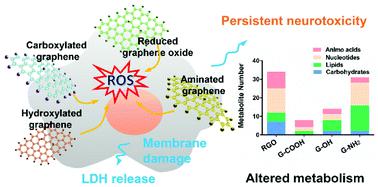Our official English website, www.x-mol.net, welcomes your
feedback! (Note: you will need to create a separate account there.)
Elucidating the mechanism of the surface functionalization dependent neurotoxicity of graphene family nanomaterials.
Nanoscale ( IF 5.8 ) Pub Date : 2020-08-18 , DOI: 10.1039/d0nr04179c Zhiling Guo 1 , Peng Zhang 2 , Andrew J Chetwynd 2 , Heidi Qunhui Xie 3 , Eugenia Valsami-Jones 2 , Bin Zhao 3 , Iseult Lynch 2
Nanoscale ( IF 5.8 ) Pub Date : 2020-08-18 , DOI: 10.1039/d0nr04179c Zhiling Guo 1 , Peng Zhang 2 , Andrew J Chetwynd 2 , Heidi Qunhui Xie 3 , Eugenia Valsami-Jones 2 , Bin Zhao 3 , Iseult Lynch 2
Affiliation

|
Graphene family nanomaterials (GFNs) have shown great potential for biological and environmental applications; however, their future use has been debated due to their reported potential neurotoxicity. Moreover, the effects of surface functionalization on their biological end points are largely unknown. Here, we compared the effects of reduced graphene oxide (RGO), and carboxylated (G-COOH), hydroxylated (G-OH) and aminated (G-NH2) graphene nanosheets on human neuroblastoma cells (SK-N-SH). All GFNs inhibited cellular growth at concentrations of 0.1–10 mg L−1 after 24 h exposure. The toxicity was attenuated over longer exposure times, with the exception of G-NH2. Although the overall acute toxicity followed the order: G-OH ≈ G-COOH > RGO > G-NH2, G-NH2 induced more persistent toxicity and more metabolic disturbance compared to the other GFNs, with lipid and carbohydrate metabolism being the most affected. The potential for physical disruption of the lipid membrane and oxidative damage induced by GFNs varied with different functionalization, which accounts for the observed differences in neurotoxicity. This study provides significant insights into the neurological effects of GFNs, and suggests that G-NH2 is not as safe as reported in many previous studies. The neurological effect of GFNs over longer term exposure should be considered in future studies.
中文翻译:

阐明了石墨烯家族纳米材料的表面功能化依赖性神经毒性的机理。
石墨烯族纳米材料(GFN)在生物和环境应用中显示出巨大的潜力。然而,由于其潜在的神经毒性,它们的未来用途受到了争议。此外,表面功能化对其生物学终点的影响在很大程度上尚不清楚。在这里,我们比较了氧化石墨烯(RGO)和羧化(G-COOH),羟基化(G-OH)和胺化(G-NH 2)石墨烯纳米片对人神经母细胞瘤细胞(SK-N-SH)的影响。暴露24 h后,所有GFN均以0.1–10 mg L -1的浓度抑制细胞生长。除了G-NH 2以外,在更长的暴露时间下毒性减弱。尽管总体急性毒性遵循以下顺序:G-OH≈G-COOH> RGO> G-NH 2与其他GFN相比,G-NH 2诱导更多的持久毒性和更多的代谢紊乱,其中脂类和碳水化合物的代谢受影响最大。GFN诱导的脂质膜物理破坏和氧化损伤的潜力随功能的不同而变化,这解释了观察到的神经毒性差异。这项研究提供了有关GFN的神经系统作用的重要见解,并表明G-NH 2不如许多先前研究所报道的安全。在未来的研究中应考虑GFN对长期暴露的神经系统影响。
更新日期:2020-09-24
中文翻译:

阐明了石墨烯家族纳米材料的表面功能化依赖性神经毒性的机理。
石墨烯族纳米材料(GFN)在生物和环境应用中显示出巨大的潜力。然而,由于其潜在的神经毒性,它们的未来用途受到了争议。此外,表面功能化对其生物学终点的影响在很大程度上尚不清楚。在这里,我们比较了氧化石墨烯(RGO)和羧化(G-COOH),羟基化(G-OH)和胺化(G-NH 2)石墨烯纳米片对人神经母细胞瘤细胞(SK-N-SH)的影响。暴露24 h后,所有GFN均以0.1–10 mg L -1的浓度抑制细胞生长。除了G-NH 2以外,在更长的暴露时间下毒性减弱。尽管总体急性毒性遵循以下顺序:G-OH≈G-COOH> RGO> G-NH 2与其他GFN相比,G-NH 2诱导更多的持久毒性和更多的代谢紊乱,其中脂类和碳水化合物的代谢受影响最大。GFN诱导的脂质膜物理破坏和氧化损伤的潜力随功能的不同而变化,这解释了观察到的神经毒性差异。这项研究提供了有关GFN的神经系统作用的重要见解,并表明G-NH 2不如许多先前研究所报道的安全。在未来的研究中应考虑GFN对长期暴露的神经系统影响。











































 京公网安备 11010802027423号
京公网安备 11010802027423号